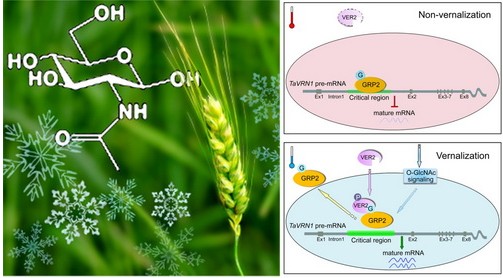Vernalization, sensing of prolonged cold, is important for seasonal flowering in eudicots and monocots. The vernalization characteristics of winter wheat varieties and the adaptedness of winter temperatures directly affect the production. This interesting complex physical phenomenon has been found since 1918. Many progress has been made in genetics and physiological research. And a series of vernalization genes have been cloned, however, how plant cells sense vernalization signal and activate molecular network is rarely reported. The resolution of molecular networks has the vital significance in wheat molecular breeding for high grain yield.
The scientists from Institute of Botany, Chinese Academy of Sciences and their collaborators found a novel mechanism that O-GlcNAc modification mediated wheat vernalization signal to start flowering network. Overexpression of vernalization induced gene (VER2) can partly replace vernalization to promote flowering. The carbohydrate-binding protein VER2, a jacalin lectin, can interact with the RNA-binding protein VIP2 (TaGRP2) to form protein complexes. And the interaction is dependent on O-GlcNAcylation of TaGRP2 at Thr17. During non-vernalization TaGRP2 binds to TaVRN1 pre-mRNA and inhibits TaVRN1 mRNA accumulation. The physical interaction between phosphorylated VER2 and TaGRP2 is controlled by TaGRP2 O-GlcNAc modification, which gradually increases during vernalization. The interaction between phosphorylated VER2 and O-GlcNAcylated TaGRP2 reduces TaGRP2 protein accumulation in the nucleus and/or promotes TaGRP2 dissociation from TaVRN1, leading to TaVRN1 mRNA accumulation. This result reveals a new mechanism for O-GlcNAc signalling in response to vernalization during the flowering transition in winter wheat, which is a significant progress in the study of flowering physiology and has the great significance for molecular breeding of wheat.
It has been published in Nature Communications on 5 August (10.1038/ncomms5572), Xiao Jun in Professor Kang Chong’s lab, is the first author of this paper. The study obtained funding from the major state basic research program of China (973) and the National Science Foundation of China.

Figure 1. GlcNAc signaling involved in vernalization in wheat.
Figure 2.Working model for VER2-TaGRP2 mediated TaVRN1 mRNA accumulation during vernalization.
Vernalization, sensing of prolonged cold, is important for seasonal flowering in eudicots and monocots. The vernalization characteristics of winter wheat varieties and the adaptedness of winter temperatures directly affect the production. This interesting complex physical phenomenon has been found since 1918. Many progress has been made in genetics and physiological research. And a series of vernalization genes have been cloned, however, how plant cells sense vernalization signal and activate molecular network is rarely reported. The resolution of molecular networks has the vital significance in wheat molecular breeding for high grain yield.
The scientists from Institute of Botany, Chinese Academy of Sciences and their collaborators found a novel mechanism that O-GlcNAc modification mediated wheat vernalization signal to start flowering network. Overexpression of vernalization induced gene (VER2) can partly replace vernalization to promote flowering. The carbohydrate-binding protein VER2, a jacalin lectin, can interact with the RNA-binding protein VIP2 (TaGRP2) to form protein complexes. And the interaction is dependent on O-GlcNAcylation of TaGRP2 at Thr17. During non-vernalization TaGRP2 binds to TaVRN1 pre-mRNA and inhibits TaVRN1 mRNA accumulation. The physical interaction between phosphorylated VER2 and TaGRP2 is controlled by TaGRP2 O-GlcNAc modification, which gradually increases during vernalization. The interaction between phosphorylated VER2 and O-GlcNAcylated TaGRP2 reduces TaGRP2 protein accumulation in the nucleus and/or promotes TaGRP2 dissociation from TaVRN1, leading to TaVRN1 mRNA accumulation. This result reveals a new mechanism for O-GlcNAc signalling in response to vernalization during the flowering transition in winter wheat, which is a significant progress in the study of flowering physiology and has the great significance for molecular breeding of wheat.
It has been published in Nature Communications on 5 August (10.1038/ncomms5572), Xiao Jun in Professor Kang Chong’s lab, is the first author of this paper. The study obtained funding from the major state basic research program of China (973) and the National Science Foundation of China.

Figure 1. GlcNAc signaling involved in vernalization in wheat.
Figure 2.Working model for VER2-TaGRP2 mediated TaVRN1 mRNA accumulation during vernalization.
